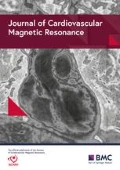Purpose
To evaluate the diagnostic performance of combined non-contrast WH-CMRA and black-blood-arterial-wall imaging in patients with suspected CAD.
Methods
Thirteen patients with suspected CAD were scanned at 1.5 T (MAGNETOM Sonata, Siemens, Germany) after written informed consent was obtained. WH-CMRA was acquired using a 3D ECG-triggered, navigator-gated, fat-suppressed, T2-prepared steady-state-free-precession sequence. Cross-sectional coronary wall imaging (thinkness = 5 mm) was performed using a 2D-black-blood, navigator and ECG-gated, Turbo-Spin-Echo sequence with asymmetric-adiabatic-spectral inversion-recovery fat suppression [3]. Continous slices without gap for wall imaging were positioned from pre to post of the suspected lesion segment perpendicular to the multi-planar reformats (MPRs) of WH-CMRA. All patients received SCA within 1 week before or after the MR examination. Image quality of WH-CMRA and vessel wall images was evaluated on a segment basis by 4-point scale (1 - poor, 4 - excellent). Segments with a score of 1 in both techniques were excluded from analysis. A positive diagnosis of CAD was made based on the MR images when at least in one of both techniques a stenosis ≥ 50% was detected by visual analysis. Only left main (LM), proximal and middle segments of right coronary artery (RCA)/left anterior descending coronary artery (LAD) were included in our study. CAD was defined positive on SCA when showing a luminal diameter reduction ≥ 50%.
Results
20/65 segments were found stenosis by WH-CMRA. The mean total scan times for WH-CMRA and coronary wall imaging were 13 ± 1.2 min, 2 ± 0.3 min respectively.10 of 20 segments were diagnosed as CAD by SCA. On a segment-based analysis, average image quality of WH-CMRA and arterial wall were 3.5 and 3.45, respectively. Two of 20 segments of wall image score were 1 because of rapid heart rate. MR results did not agree with SCA in one of 20 caused by high BMI (34.17) and irregular breathing. The sensitivity of WH-CMRA only and WH-CMRA combined with arterial wall were (8/10) and (9/10), NPV (10/12) and (10/11), PPV(8/8) and (9/9) respectively. No difference of specificity (10/10) between the two groups Figure 1 and table 1.
59-Y man w. typical chest pain. MPRs of WH-CMRA (1b, 1c) show significant stenosis (≥ 50%) in middle segments of LAD, consistent with findings of SCA (1a). 2D black blook coronary wall images were acquired pre/mid/post LAD lesion (1d). Mid slice shows stenosis >50% while lumen in slice pre, post is <50%.
Conclusion
The combination of WH-CMRA and black blood coronary wall imaging improves diagnostic accuracy to detect CAD over WH-CMRA alone. The study with larger sample size is under investigation.
References
Yang Q et al: JACC. 2009, 54: 69-76.
Miao C et al: JACC. 2009, 53: 1708-1715.
Shea S et al: Proc ISMRM. 2007, 15: 2475-
Author information
Authors and Affiliations
Rights and permissions
Open Access This article is published under license to BioMed Central Ltd. This is an Open Access article is distributed under the terms of the Creative Commons Attribution 2.0 International License (https://creativecommons.org/licenses/by/2.0), which permits unrestricted use, distribution, and reproduction in any medium, provided the original work is properly cited.
About this article
Cite this article
Dai, Q., Zhang, Z., He, Y. et al. Diagnostic performance of non-contrast whole-heart coronary magnetic resonance angiography combined with black-blood arterial wall imaging in patients with suspected coronary artery disease. J Cardiovasc Magn Reson 12 (Suppl 1), P38 (2010). https://doi.org/10.1186/1532-429X-12-S1-P38
Published:
DOI: https://doi.org/10.1186/1532-429X-12-S1-P38


